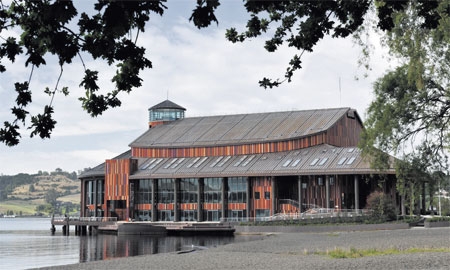Chile’s cultural movements have produced some of the Spanish-speaking world’s greatest artists, especially in terms of poetry and literature. For example, the two Chilean recipients of the Nobel Prize, Pablo Neruda and Gabriela Mistral, were both writers.
Pablo Neruda – whose charming homes in Valparaiso, Santiago and Isla Negra have been lovingly preserved and opened to the public – was a writer, poet and politician whose political activism and support for the Communist party landed him in self-exile during the 1940s. Later described by Colombian writer Gabriel Garcia Marquez as “the greatest poet of the 20th century in any language,” Neruda and his works have inspired musicians, writers and filmmakers around the world.
One of Neruda’s mentors growing up was Gabriela Mistral, 15 years his senior. The first Latin American woman to win the Nobel Prize in Literature (1945), she was also a poet, as well as a teacher, diplomat and feminist. An acquaintance of various Latin American leaders and of Eleanor Roosevelt, Mistral lived much of her adult life between Europe and North America. Her poems are renowned for dealing with difficult subjects – from maternity, love, death and sorrow to betrayal and the Latin American identity – in a broader yet more profound manner than her contemporaries.
Chile’s two most beloved singer-songwriters, famous throughout the Spanish-speaking world, were also poets in their own right known not only for their music but also for their political views. Violeta Parra, whose 1966 song “Gracias a la Vida” was later recorded by Joan Baez in 1974 and still holds the title as one of the best-known Latin American songs in history, reinvented Chilean folk music and extended its popularity far beyond Chile’s borders as part of the “New Song Movement” (“Nueva Cancion”). This new genre of socially committed folk music soon took hold in Argentina, Cuba, Spain and other countries under military dictatorships.
Victor Jara, another proponent of the “New Song Movement”, became a symbol of the struggle for human rights across the region after he was brutally tortured and killed during the political upheaval of 1973. Although many master recordings of Jara’s music were destroyed by Pinochet’s regime, his wife, Joan Jara, escaped Chile with some tapes, which were copied and distributed globally.
CHILE BOASTS TWO NOBEL LAUREATES IN LITERATURE: GABRIELA MISTRAL AND PABLO NERUDA
THE ‘NEW SONG MOVEMENT’ THAT INSPIRED A NEW GENRE WAS BORN IN CHILE
ONE OF THE WORLD’S MOST WIDELY READ SPANISH LANGUAGE WRITERS IS CHILEAN ISABEL ALLENDE
SANTIAGO’S MUSEUM OF FASHION IS ‘THE MOST REMARKABLE CULTURAL SPACE IN RECENT YEARS’ |
Chile’s most prominent writer still alive today is undoubtedly Isabel Allende (now a U.S. citizen), who in 2004 was inducted into the American Academy of Arts and Letters. Best known for her book “The House of the Spirits”, Allende is one of the world’s most widely read Spanish-language authors.
So ingrained are literature, music and art in the Chilean way of life that the business world jumps at the opportunity to back various cultural projects that showcase Chilean culture.
A beautiful example of this is Empresas Transoceanica’s brand new Teatro del Lago (Theater of the Lake) in the southern town of Frutillar.
Chile is also renowned regionally as an artistic center thanks to its National Museum of Fine Arts (MNBA is its Spanish acronym). Founded in 1880, the MNBA is the oldest museum on the continent and its current building, the “Palace of Fine Arts”, sits alongside the University of Chile’s Museum of Contemporary Art in the capital’s pleasant Parque Forestal, or Forest Park.
Santiago’s newest museum, the Museum of Fashion, has been described by The New York Times as “the most remarkable cultural space that has opened in recent years.” This private museum was opened by Jorge Yarur Bascuñan, who was inspired by his socialite mother’s collection of fabulous designer dresses and suits. His childhood home, a rehabilitated 1960s modernist mansion, plays host to a permanent collection of some 10,000 pieces of couture and memorabilia that also include apparel worn by Arnold Schwarzenegger (as the Terminator), John Lennon, and Princess Diana.

0 COMMENTS